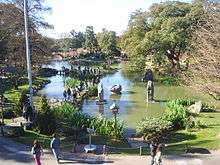Japanese Argentines
| Total population | |
|---|---|
|
11,711 Japanese nationals 23,000 Argentines of Japanese descent Total: 34,711 | |
| Regions with significant populations | |
| Greater Buenos Aires, La Plata Partido, Escobar Partido, Misiones Province | |
| Languages | |
| Rioplatense Spanish · Japanese | |
| Religion | |
| Buddhism · Roman Catholicism · Shintoism | |
| Related ethnic groups | |
| Japanese diaspora · Asian Argentines |
Japanese Argentines or Japanese Argentinians (Spanish: nipo-argentinos, Japanese: 日系アルゼンチン人 Nikkei Aruzenchin-jin) are Argentine citizens of Japanese ancestry, comprising Japanese immigrants and their descendants born in Argentina. Japanese migration to Argentina began in 1908 with the arrival of immigrants from Okinawa and Kagoshima.[1] The first Japanese entered the country via Brazil, and succeeding groups of immigrants tended to reach Argentina through the neighboring nations. In the pre-war years, Japanese Argentines were concentrated in urban small businesses, especially dry cleaning and cafes in Buenos Aires, while some worked as domestic servants, factory workers, and longshoremen. A minority of Japanese Argentines also engaged in horticulture, floriculture, and fishery. There is an important Japanese community in the city of Belén de Escobar where they settled and specialised in floriculture.
Between the 1960s and 1970s, more Japanese immigrants arrived in the country. Many were attracted by the economic opportunities in agriculture. According to the Ministry of Foreign Affairs there are 23,000 nikkei and 11,711 Japanese nationals in Argentina for a total of 34,711 people.
Culture

In regions with a substantial Japanese population in Buenos Aires, institutions such as Japanese associations and Japanese language schools were established by early Japanese immigrants.
During the United States-Japanese conflict of World War II, Argentina remained neutral until 1943, which limited the impact of war on the lives of Japanese Argentines. However, restrictions included the ban on meetings, Japanese education, newspaper publication, as well as a freeze on Japanese assets—which remained effective between 1944 and 1946.
See also
References
- ↑ "Migration Historical Overview - Argentina", Discover Nikkei, 12 September 2007.